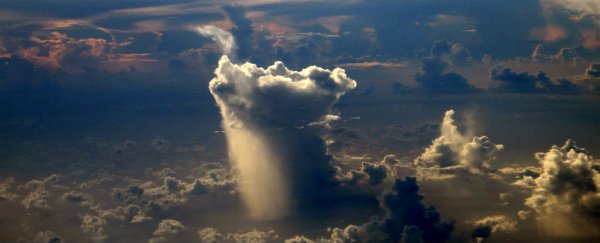This month, the percentage of California still stuck in a drought dropped by 22 percent in a single week, as the wettest winter in decades saw an onslaught of storms deliver record-breaking rains across the state.
Now, researchers have connected the chaos to a strange phenomenon known as atmospheric rivers - narrow corridors of concentrated moisture suspended in the atmosphere, which can hold up to 15 times more water than the amount that flows through the Mississippi River.
If you're unfamiliar with atmospheric rivers, or are wondering if that's just a fancy name for "rain", they're actually a unique movement of moisture through Earth's atmosphere, responsible for most of the horizontal transport of water vapour outside the tropics.
These suspended moisture plumes, which can stretch 400 to 600 km wide (250 to 370 miles), have been linked to all seven floods on California's Russian River between 1996 and 2007, and likely played a role in the 'Snowmageddon' event that blanketed the East Coast in 2010.
All 10 of Britain's largest floods since the 1970s have also been attributed to atmospheric rivers, and late last year, researchers linked them to their first ever mass die-off event, when nearly 100 percent of wild oysters in northern San Francisco Bay mysteriously disappeared in 2011.
Now, scientists led by Duane Waliser, an atmospheric scientist at NASA's Jet Propulsion Laboratory, have found that massive atmospheric rivers are responsible for up to 75 percent of all extreme wind and rainfall events on the world's coasts, and half of the strongest wind gusts recorded in nearly two decades.
The team also linked them to up to 65 percent of the extreme rain and snow events in the Western United States - such as the storm that hit Northern California on Monday - and say they could also be the cause of 80 percent of major floods in the state.
Last month, a state of emergency was called in various California countries due to devastating storms linked to atmospheric rivers, and just recently, the five-year drought dropped to less than a quarter of the state in a single week, with rainfall hitting almost 200 percent above average in certain parts of the Bay Area.
And the phenomenon is showing no signs of slowing down, with a flood warning affecting 14 million people in California to remain in place until at least Thursday.
Another #AtmosphericRiver aimed at #California. Flooding expected. #PineappleExpress #CAwx https://t.co/MXC7baDhlM pic.twitter.com/JgKKDGtJ81
— UW-Madison CIMSS (@UWCIMSS) February 20, 2017
The US National Weather Service (NWS) is now saying that storms to come could cause floods in areas that have not been flooded in decades, and are warning locals in Northern California to be ready to evacuate at 15 minutes notice.
"This has been a very active winter, atmospheric river-wise," Jeff Zimmerman from the NWS, who wasn't involved in the study, told NPR. "We've probably had 10 or more … this winter."
To put that into perspective, an average year will usually only have five to seven atmospheric rivers.
Waliser and his team measured the influence of atmospheric rivers by analysing data from storms around the globe in regions outside the tropics from 1997 to 2014.
When they focussed on the top 2 percent windiest storms, they found that "atmospheric rivers are typically associated with 30, and even up to 50 percent, of those very extreme cases", and almost the same amount of the wettest storms, Christopher Joyce reports for NPR.
And perhaps even more worrying, winds associated with atmospheric rivers were found to be twice the speed of the average storm - strong enough to topple even the great Pioneer Cabin Tree - a 1,000-year-old Californian sequoia that finally fell last month.
"Not only do [atmospheric rivers] come with this potential for flooding hazards," Waliser told NPR, "they also come with potential for high impact winds and extremes that can produce hazardous conditions."
While atmospheric rivers are naturally occurring phenomena, climate change is expected to intensify the severe precipitation events caused by atmospheric rivers in the future, because of increased evaporation rates and greater atmospheric water-holding capacity.
So as the state recovers from fighting a five-year drought - that's still not over, despite the record rains - it now has to deal with oppressive storms, and scientists are saying this crazy winter is likely a sign of things to come.
"The current situation in California - specifically, the dramatic swing from extreme drought to water overabundance and flooding - is indeed a preview of California's likely climate future," one of the team, climate scientist Daniel Swain from UCLA, told Mashable.
"There is now quite a bit of evidence that future droughts here will be warmer and more intense, yet will be interrupted by increasingly powerful 'atmospheric river' storms capable of causing destructive flooding."
Stay safe out there, guys.
The research has been published in Nature Geoscience.
